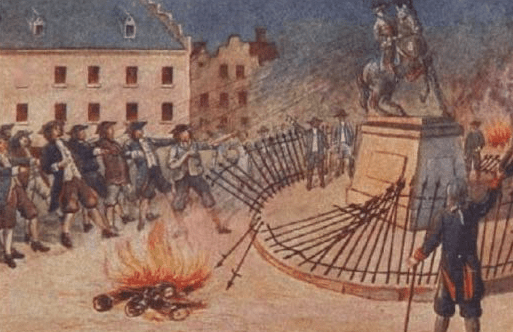
 Readers of New York Almanack can expect to see lots of coverage of events related to the America 250 commemoration over the next year or so. The events and programs are likely to be mostly based around major events, such as the Battle of Saratoga.
Readers of New York Almanack can expect to see lots of coverage of events related to the America 250 commemoration over the next year or so. The events and programs are likely to be mostly based around major events, such as the Battle of Saratoga.
But there might be another way to gain perspective on the American Revolution in New York, one that focuses on some original documents. A few revealing documents are noted below. They illustrate a pattern that will recur in New York history: our state sometimes hesitates but then assumes a leadership role in effecting change.
1. Hoping for reconciliation, March 25, 1775
Journal of the Votes and Proceedings of the General Assembly of the Colony of New York, 109-117.
As the colonies moved toward rebellion against Britain, New York at first hesitated. Many New Yorkers were loyalists, and New York City, surrounded by water, would be vulnerable to British occupation. New York’s colonial Assembly, a representative body that legislated on local matters and advised the Royal governor, sought some way to avoid the break.
In March, 1775, the Assembly passed three petitions – one to the King, one to Parliament, and one to the House of Lords. The central message: New Yorkers are loyal subjects but they demand their rights as Englishmen, including the right to be taxed by their own representatives. At that time, even some patriots who would soon become leaders of the rebellion still hoped for reconciliation.
2. Appealing for full support, December 1776
“Address of the Convention of the Representatives of the State of New York,” December 1776.
New York convened four “Provincial Congresses” in 1775-1776, and the fourth one assumed the name of “Representatives of the State of New York” in December 1776, despite the fact that the “State of New York” did not yet exist.
The convention also urged New York’s citizens to fully support the rebel cause. Its appeal to the public, issued in December 1776, came at a time when the military situation was bleak. In some ways it resembled Thomas Paine’s booklet Common Sense, published the previous summer, making a strong case for independence.
3. The first Constitution brings the STATE of New York into existence, April 20, 1777
Soon after the Convention of Representatives of the State of New York issued the plea for citizen support in document 2, it turned to writing a constitution for New York. The Convention met in Kingston, a safe haven from British authorities.
It outlined the format and functions of state government, in effect, bringing the new state government to life when it was promulgated on April 20 in Kingston. The document outlined the structure and functions of the new government. In effect, it brought the State of New York into existence.
4. The new Chief Justice explains citizens’ rights and responsibilities under the new constitution, September 9, 1777
“To the Grand Jury of Ulster County,” September 9, 1777.
What did it really mean to say that New Yorkers were no longer subjects of a king bur instead self-governing through their own elected representatives?
Attorney John Jay, who had been the lead writer of the 1777 state constitution began in the fall to serve as the state’s first Chief Justice.
He took the occasion of instructing the jury in his first trial go well beyond describing just their technical responsibilities and to provide an eloquent explanation of the significance of the document and the government it created and the responsibilities of citizens in a representative form of government.
The new state government printed the speech as an official document and distributed it widely.
5. The new governor defines the Executive’s role, September 10, 1777
“Opening Speech,” September 10, 1777
After the constitution was promulgated, the convention quickly arranged for elections, and General George Clinton was elected governor.
In his first speech to the legislature, which happened to be the day after the Chief Justice’s speech cited in Document 4, the new governor set the tone, promising to fully carry out the executive powers in the constitution and urging the lawmakers to act on urgent matter, particularly, raising funds for the war effort.
Over the next few says, the Assembly issued are response to the governor’s speech, Clinton offered his own response to the Assembly’s response, and the long discussion of the balance of power between the executive and legislative branches began and continues to the present day.
6. New York adopts a Bill of Rights, January 19, 1787
The first State Constitution, adopted in 1777, left some issues unaddressed. These had to be remedied in the next few years.
The document guaranteed freedom of religion but not other rights. This omission was addressed by legislation a decade later, which guaranteed protection of free speech and press, trial by jury, the right to petition the government, due process of law, taxes could be levied only with the people’s consent, and other freedoms.
This Bill of Rights was later expanded, included in subsequent revisions of the state constitution, and is the predecessor of the Bill of Rights in the state constitution today.
7. New York joins the new United States, July 26, 1788
In the years after the Revolution ended, New York’s founder differed about the nature of the national government. Some, such as George Clinton, wanted the states to be predominant.
But others, such as John Jay and Alexander Hamilton, thought the Articles of Confederation too week and the national government ineffective. Hamilton led the movement for a Constitutional Convention, which wrote a new U.S. Constitution, and send it to the states for ratification.
New York’s ratifying convention was divided, Clinton opposing and Hamilton, Jay and others supporting. The final vote, in favor, on July 26, 1788, was close.
The convention recommended adding a Bill of Rights to the constitution, which was done in 1791. Perhaps no surprise, the Bill of Rights resembled New York’s own 1787 Bill of rights, noted in Document 6.
The most persuasive document in effecting ratification was a paper written by John Jay, “Address to the People of the State of New York,” April 15, 1788.
Jay argued that the new Constitution was a careful compromise and that it would benefit New York as well as the rest of the nation. The arguments were used in discussions over the summer and in the convention that ratified the Constitution in the fall.
8. New York abolishes slavery, March 29, 1799
“An Act for the Gradual Abolition of Slavery,” New York Session Laws, 22nd Session, Chapter 62.
John Jay and others had pushed for the abolition of slavery in the 1777 constitution, but it found little support. That glaring omission was not remedied until 1799 when Jay, by then governor, signed a bill for the gradual abolition of slavery.
The law set a date of July 4, 1827, for the complete and final abolition of slavery in New York.
In a sense, the abolition of slavery was an end to the Revolutionary Era in New York. But New York was just getting started! It would continue to be a state where revolution-scale events would be commonplace.
Illustration: Patriots topple the Bowling Green statue of King George III on July 9, 1776.








Recent Comments